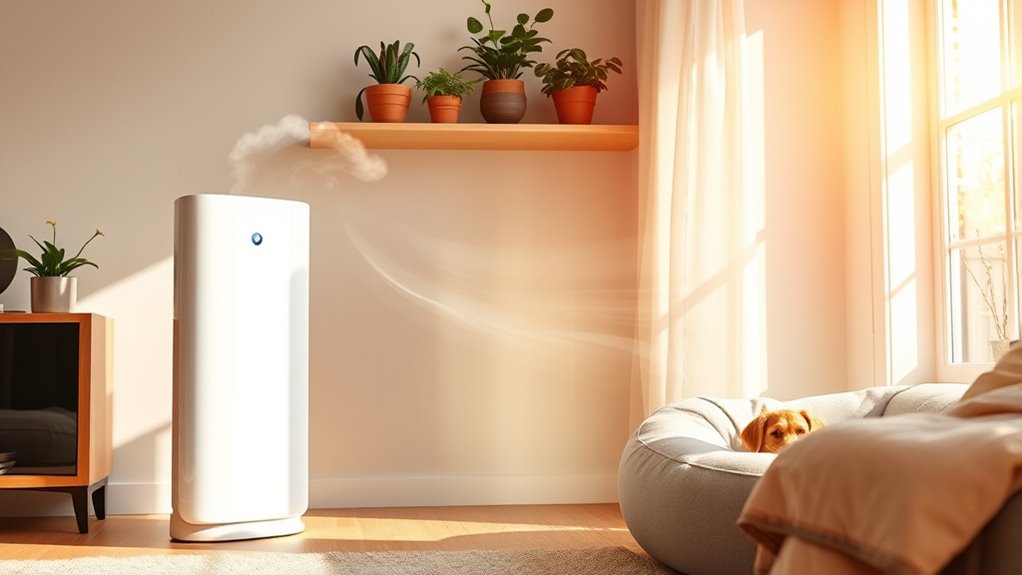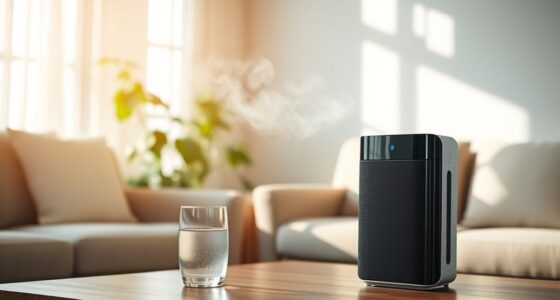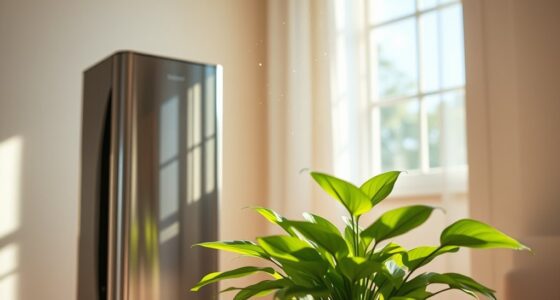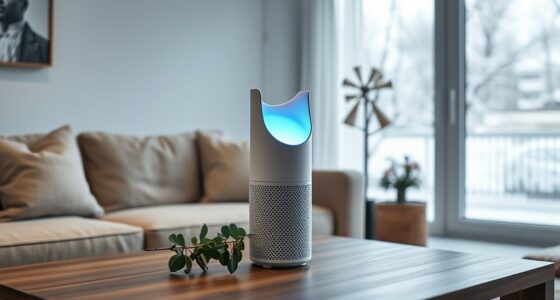Air purifiers help reduce household odors by using advanced filtration technology, like HEPA and activated carbon filters. They capture and neutralize smells from cooking, pets, and cleaning products, improving your home’s air quality. While they can’t eliminate every scent, they greatly diminish unwanted odors, making your living space fresher. Regular maintenance is key for peak performance. Discover how to choose the right purifier and maintain it effectively for even better results.
Key Takeaways
- Air purifiers equipped with HEPA and activated carbon filters capture airborne particles and adsorb odor-causing gases, effectively reducing household odors.
- Activated carbon filters bind odors and VOCs, preventing them from re-entering the air, leading to a fresher environment.
- Bipolar ionization technology neutralizes odor molecules, enhancing the overall effectiveness of air purifiers in odor management.
- Regular maintenance and timely filter replacements ensure optimal performance and sustained odor reduction capabilities of air purifiers.
- Combining air purifiers with good ventilation maximizes their ability to eliminate persistent odors in the home.
Understanding Household Odors and Their Sources
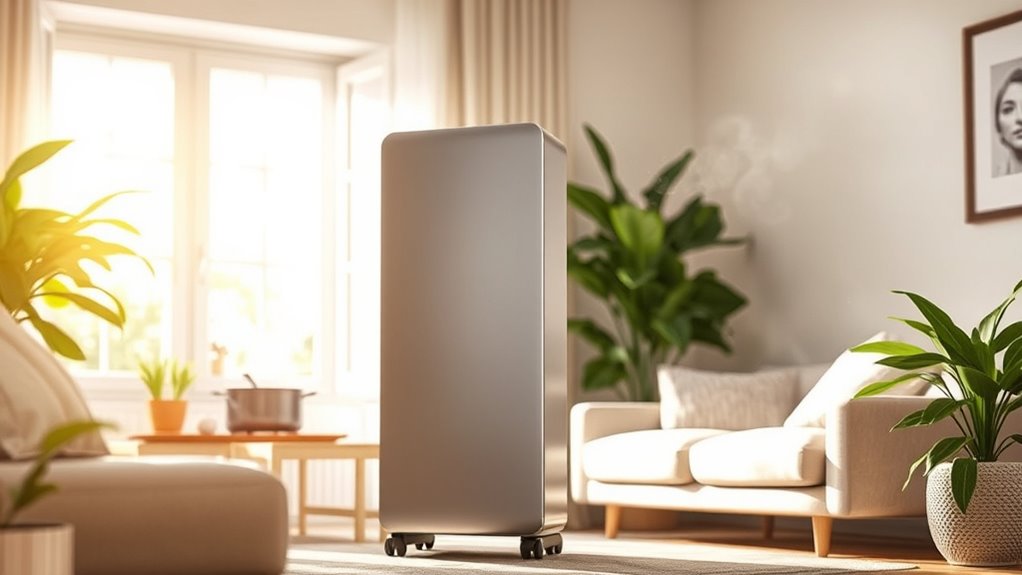
Understanding household odors is essential, especially since they can stem from various sources around your home.
Cooking strong-smelling foods, like fish, often creates persistent odors that linger without proper ventilation. Pets can contribute to unwanted smells as well, while cleaning products and air fresheners release volatile organic compounds (VOCs) into your indoor air. Regular maintenance of air purifiers can help ensure they effectively reduce household odors, enhancing the overall air quality. Furthermore, many air purifiers incorporate HEPA filters, which capture airborne particles that may also contribute to unpleasant scents. Additionally, air purifiers can significantly mitigate the impact of these odors by filtering out harmful pollutants. Properly maintaining your air purifier will ensure it functions at its best and uses manufacturer guidelines to enhance performance.
Strong-smelling foods, pets, and cleaning products can all contribute to lingering household odors and compromised air quality.
These VOCs and other airborne pollutants can compromise your home’s air quality, causing discomfort and potential health issues. Additionally, new building materials like carpets and vinyl flooring may emit odors, particularly when first installed.
Poor airflow and inadequate ventilation can exacerbate these odors, making it vital to address these factors for a fresher environment. Using an air purifier with activated carbon filters can effectively absorb odors and VOCs, enhancing your indoor air quality. Regularly checking and cleaning your filters will ensure that your air purifier operates efficiently and maintains optimal performance.
How Air Purifiers Work to Eliminate Odors
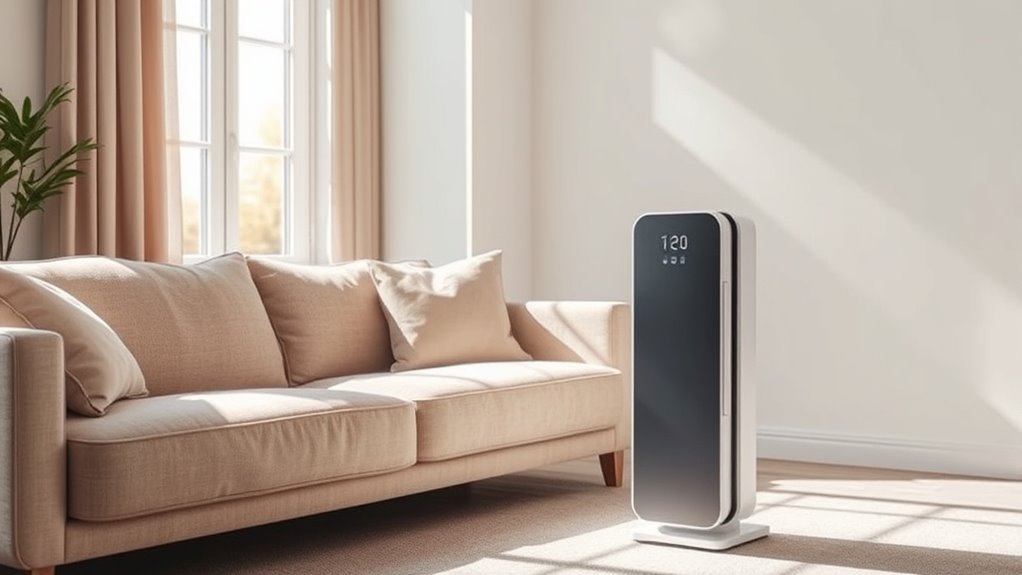
Air purifiers effectively combat household odors by utilizing advanced filtration technologies. They primarily rely on HEPA filters and activated carbon filters to tackle airborne contaminants. While HEPA filters capture particulate matter, activated carbon filters absorb odor-causing gases and volatile organic compounds (VOCs), making them essential for removing odors. For instance, ISO-Aire carbon air purifiers feature V-Bank carbon filters that enhance the adsorption of odor molecules, effectively targeting unwanted smells from cooking and other sources. Additionally, HEPA filters are known to remove 99.97% of airborne pollutants, contributing to a fresher indoor environment. Regular filter cleaning and replacement is crucial for maintaining optimal performance and ensuring that the air purifier continues to effectively reduce odors. Moreover, understanding investment strategies related to home improvement can also enhance the value of your living space.
Furthermore, many advanced purifiers incorporate bipolar ionization technology, which neutralizes odor particles, enhancing overall odor removal capabilities. This technology is part of the air ionizers that release negative ions to neutralize airborne pollutants. Notably, the Winix 5500-2 Air Purifier features PlasmaWave technology, which neutralizes odors and allergens, providing an extra layer of filtration. To guarantee peak performance, you should combine air purifiers with proper ventilation and regular filter maintenance, maximizing their effectiveness in reducing household odors.
The Role of Activated Carbon Filters in Odor Removal
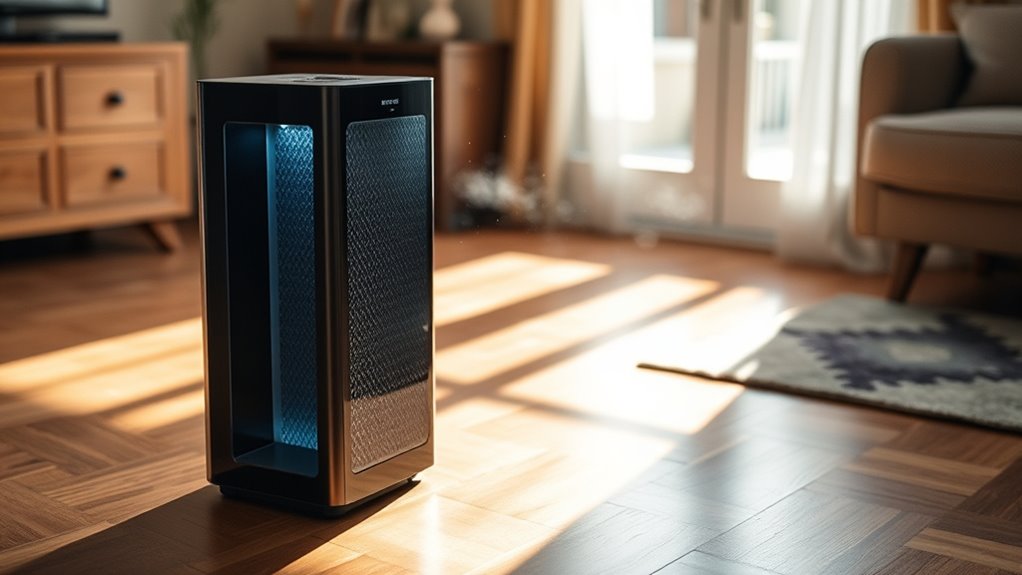
While HEPA filters play an essential role in capturing particulate matter, activated carbon filters take on the challenging task of eliminating odors.
These filters excel at removing odors from cooking, pets, and chemicals due to their porous structure, which adsorbs a wide range of gaseous particles. The adsorption process binds odor and volatile organic compounds (VOCs) to the carbon, effectively trapping them and preventing their return to your air. Research-backed articles highlight the efficiency of activated carbon in reducing household odors. Additionally, integrating smart home devices with air purifiers allows for enhanced control and monitoring of indoor air quality. Remarkably, using dry ice in conjunction with air purifiers can create even cooler and fresher air by reducing the overall temperature, which can aid in the effectiveness of odor removal. The use of natural remedies can also complement the benefits of air purifiers by improving overall indoor atmosphere.
Activated carbon filters effectively eliminate odors from cooking, pets, and chemicals by adsorbing a variety of gaseous particles.
Some activated carbon filters, like the SmokeStop™, contain 2-4 lbs of carbon, greatly boosting their ability to absorb larger quantities of odors.
When you use air purifiers with HEPA and activated carbon filters together, you achieve thorough air purification, tackling both particulate matter and odor-causing gases simultaneously. Additionally, using heat pumps can further enhance indoor air quality, providing a comprehensive solution for a healthier living environment.
Types of Air Purifiers Effective Against Odors
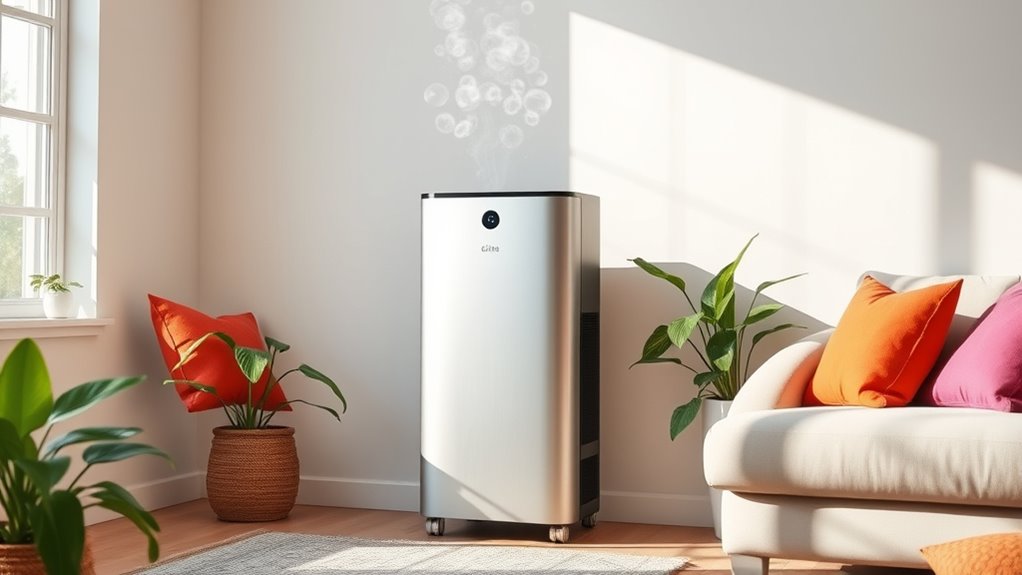
When it comes to tackling household odors, activated carbon filters are your best bet for absorbing and neutralizing unwanted smells. HEPA air purifiers can enhance air quality too, but they often need charcoal filters to effectively manage odors. Combining these technologies gives you a powerful solution for both particles and smells in your home. Additionally, incorporating essential oils can provide a pleasant aroma while purifying the air; for example, eucalyptus oil is known for its decongestant effects and can help freshen the indoor atmosphere. Furthermore, using well-seasoned wood in wood-burning stoves can help reduce smoke and odors, promoting a cleaner indoor environment. Regular maintenance of your air purifier, such as filter replacement, ensures optimal performance and continued odor reduction. Implementing energy-efficient technology in your air purification system can also lead to better overall air quality and reduced operational costs.
Activated Carbon Filters
If you’re looking to tackle household odors effectively, activated carbon filters are a must-have in your air purifier.
These filters excel at adsorbing odor-bearing gases and volatile organic compounds (VOCs), making them essential for removing unpleasant smells from your home.
Here’s why activated carbon filters are so effective:
- They bind to and eliminate those stubborn odor-bearing gases.
- They enhance your air purifier’s ability to create a fresher environment.
- Regular maintenance and timely replacements boost their efficiency.
- Proper air purification can also improve color accuracy in your home cinema experience.
HEPA With Carbon
Combining HEPA and activated carbon filters in air purifiers offers a powerful solution for tackling household odors. A HEPA air purifier captures 99.97% of airborne particles as small as 0.3 microns, while activated carbon filters specifically target and absorb gaseous odor-bearing pollutants, making them highly effective for odor removal.
This duo enhances indoor air quality by addressing both particulate matter and unpleasant smells simultaneously. Activated carbon filters utilize a sorption process that binds and neutralizes odors from cooking, pets, and chemicals.
If you’re dealing with strong or persistent smells, consider models equipped with V-Bank carbon filters for optimal absorption. Additionally, including technologies like bipolar ionization can further improve effectiveness by neutralizing odor molecules in the air.
Benefits of Using Air Purifiers for Odor Control
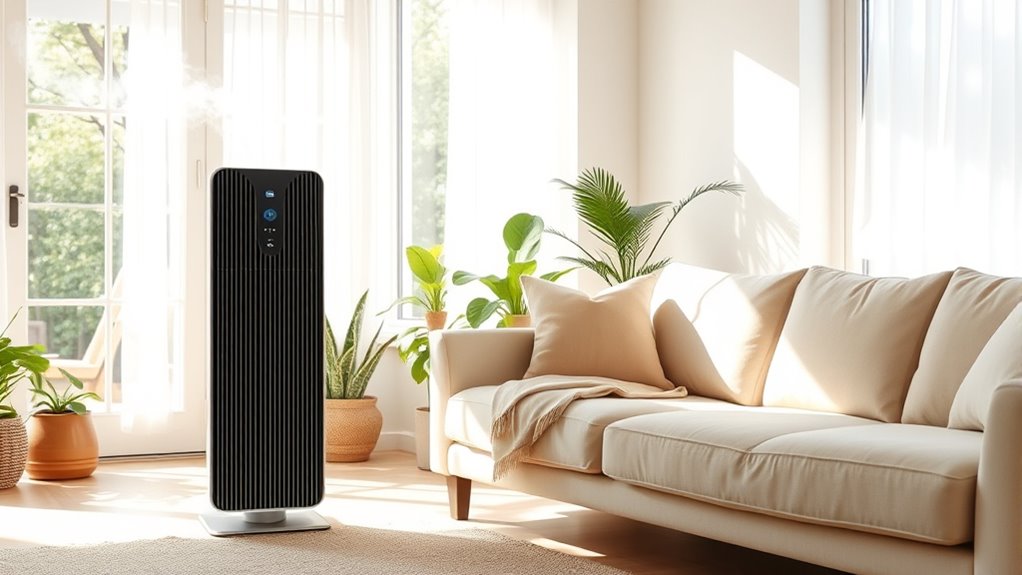
When you use air purifiers, you’re not just improving air quality; you’re also capturing odor molecules that linger in your home.
With the right filters, these devices can substantially reduce unwanted smells over time.
That means you can enjoy a fresher, more pleasant living environment with less effort.
Enhanced Air Quality
Air purifiers greatly enhance indoor air quality by effectively controlling odors, especially those from cooking or volatile organic compounds (VOCs).
By using HEPA air purifiers combined with activated carbon filters, you can enjoy a fresher environment.
Here are some benefits of improved air quality:
- Fresher Home: Eliminate unpleasant smells from cooking and other sources.
- Healthier Living: Reduce harmful airborne contaminants, making your space safer.
- Comfortable Atmosphere: Create a more inviting environment for family and guests.
Choosing the right air purifier tailored to your space is essential.
Regularly maintaining filters guarantees peak performance in tackling odor-bearing gases, allowing you to breathe easier and enjoy a cleaner home.
Odor Molecule Capture
Odor control is essential for maintaining a pleasant home environment, and air purifiers equipped with activated carbon filters excel at capturing and absorbing odor molecules.
These filters specifically target a wide range of unpleasant smells, including cooking odors, smoke, and volatile organic compounds (VOCs).
While HEPA filters are great for trapping particles, they don’t effectively capture gaseous odor-bearing particles. This is where the combination of HEPA and activated carbon filters becomes vital for extensive odor molecule capture.
Additionally, technologies like bipolar ionization enhance the removal capabilities of these filters, allowing you to enjoy fresher air.
Long-Term Odor Reduction
Combining activated carbon filters with HEPA technology not only captures odor molecules effectively but also promotes long-term odor reduction in your home.
With air purifiers, you’ll experience a significant improvement in your indoor air quality, guaranteeing that unwanted smells don’t linger.
Here are three key benefits of using these powerful devices:
- Eliminates Persistent Odors: Say goodbye to cooking smells and pet odors that can stick around for days.
- Enhances Air Quality: A HEPA filter combined with activated carbon traps harmful particles and gaseous pollutants.
- Sustains Freshness: Regular maintenance guarantees your air purifier continues to function at its best, keeping your home smelling fresh.
Invest in an air purifier and enjoy a cleaner, more pleasant living environment.
Limitations of Air Purifiers in Smell Elimination
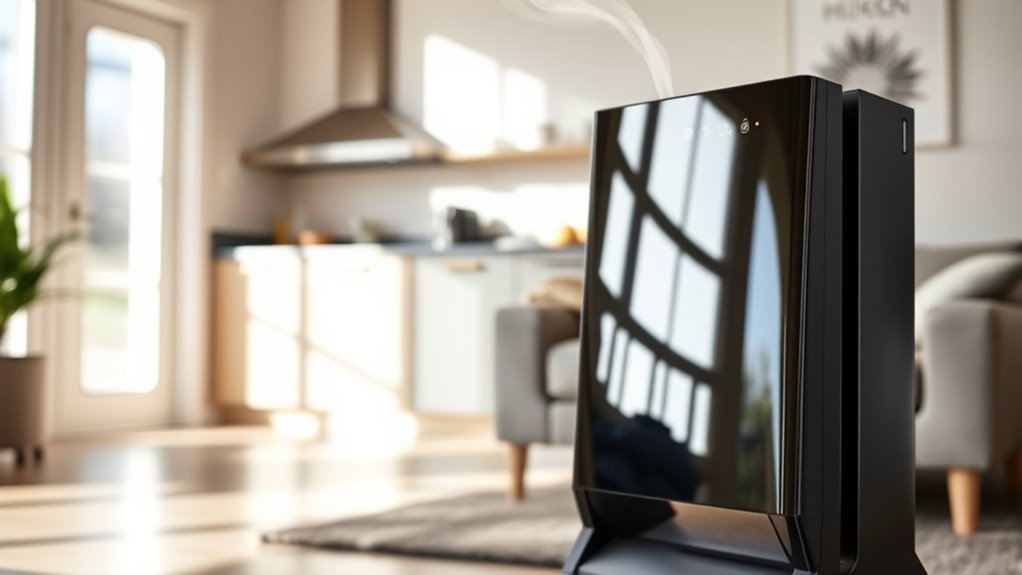
While many homeowners rely on air purifiers to create a fresher environment, their limitations in eliminating odors shouldn’t be overlooked.
Air purifiers are primarily designed to capture particulate matter and harmful contaminants, not specifically to target odors. Gaseous odor-bearing particles can be smaller than 0.001 microns, making them difficult for standard HEPA filters to capture effectively.
While activated carbon filters can absorb some odors, they can’t eliminate all gas pollutants, leaving some smells lingering. Additionally, no air purifier can guarantee complete odor removal due to the strong volatility of certain smells and environmental factors.
The EPA also recommends using air purifiers as a supplementary method, emphasizing that good ventilation is vital for peak odor management.
Choosing the Right Air Purifier for Your Needs

Have you ever wondered how to select the best air purifier for tackling household odors? Here are three key factors to take into account:
- Filter Type: Choose a model with both HEPA and activated carbon filters to effectively capture particulate matter and neutralize odor molecules.
- Clean Air Delivery Rate (CADR): Confirm the purifier’s CADR matches your room size for maximum effectiveness in odor removal.
- Special Features: Look for additional features like ozone-free bipolar ionization, which can enhance odor elimination without harmful emissions.
Maintenance Tips for Optimal Air Purifier Performance
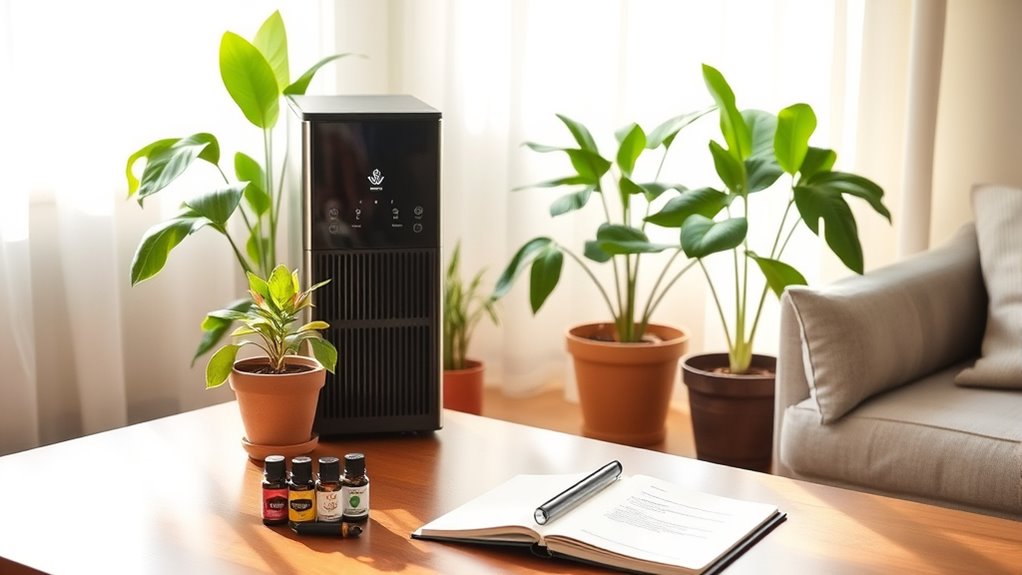
Selecting the right air purifier is just the beginning; keeping it well-maintained guarantees it performs at its best.
Regularly replace or clean filters according to the manufacturer’s guidelines. Clogged filters can greatly reduce your air purifier’s effectiveness in removing odors and contaminants.
Monitor the air quality indicator lights for real-time feedback on when maintenance or filter changes are needed. Make certain the area around your air purifier is free from dust and obstructions to promote proper airflow.
Schedule routine checks of activated carbon filters, as they can saturate and lose their ability to absorb odors, typically requiring replacement every 6 to 12 months.
Also, make sure your air purifier is appropriately sized for the room to maximize its efficiency.
Enhancing Indoor Air Quality Beyond Air Purifiers
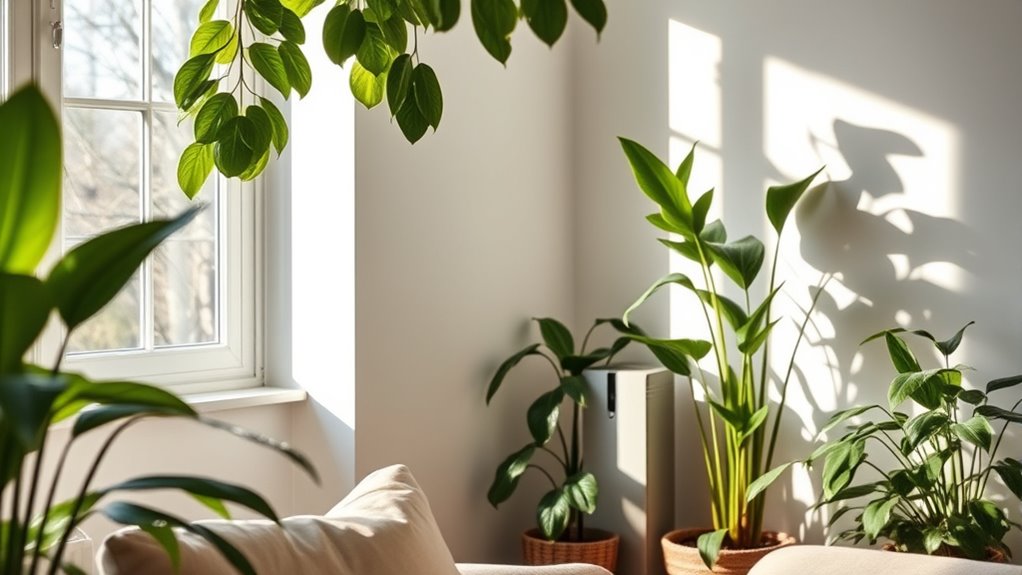
To truly enhance indoor air quality, it’s important to look beyond just air purifiers.
Consider these strategies to create a fresher environment:
- Good ventilation: Open windows and use exhaust fans to dilute odors and VOCs, allowing fresh air to circulate.
- Natural air fresheners: Opt for essential oils or plants like peace lilies, which provide pleasant scents without harmful chemicals.
- Regular cleaning: Establish a routine for dusting, vacuuming, and washing surfaces to eliminate allergens and odor-causing particles.
Additionally, choose low-VOC materials for your home furnishings to further minimize harmful chemicals.
Frequently Asked Questions
Do Air Purifiers Make a House Smell Better?
Yes, air purifiers can make your house smell better. They work by filtering out unwanted odors that linger in the air.
When you use an air purifier with activated carbon filters, it absorbs and neutralizes various smells from cooking, pets, or smoke. This means you’ll breathe cleaner, fresher air in your home.
How Long Does It Take an Air Purifier to Remove Odors?
Imagine a sponge soaking up spilled water; that’s how quickly an air purifier can tackle odors.
Generally, it takes just a few hours for an effective model to start reducing smells. However, the complete removal could take longer, depending on the odor’s strength and the purifier’s capabilities.
With continuous operation and good airflow, you’ll notice a fresher space as lingering scents dissipate, revealing a cleaner environment you’ll enjoy coming home to.
Will an Air Purifier Help With Musty Smell in House?
Yes, an air purifier can help with musty smells in your house.
It works by adsorbing odor-bearing particles and volatile organic compounds that contribute to those unpleasant scents.
To get the best results, make sure to choose a unit with an appropriate Clean Air Delivery Rate (CADR) for odors.
Don’t forget to regularly replace filters and consider improving ventilation and humidity control to tackle the root causes of mold and mildew.
What Filter Type Is Best for Removing Odor From Air?
When it comes to removing odors from the air, activated carbon filters are your best bet. They absorb and capture odor-bearing gases effectively, making them perfect for tackling unpleasant smells.
If you want maximum performance, look for air purifiers that combine HEPA filters with activated carbon, as they’ll handle both particles and odors.
Additionally, consider models with bipolar ionization technology for enhanced odor neutralization. You’ll notice a fresher environment in no time!
Conclusion
To sum up, using air purifiers can be a game changer for tackling household odors. They actively filter the air, helping you breathe easier and enjoy a fresher home environment. While they’re not a cure-all, pairing them with good cleaning habits can really help you take the bull by the horns when it comes to odor control. So, invest in the right air purifier, and you’ll notice a significant difference in your indoor air quality.
